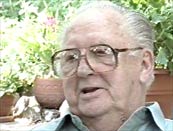Tell us about your ideas for designing the bridge.
 It was pretty well established with the model that the things was going to be in a full circle. From there it became a question of how we were going to make it, how it could come apart, where the cameraman could get into it.
It was pretty well established with the model that the things was going to be in a full circle. From there it became a question of how we were going to make it, how it could come apart, where the cameraman could get into it.
Of course, every director that came in wanted to pan three hundred and sixty right roundy-roundy. We�d tell them it�s just going to wind up on the cutting room floor, it isn�t going to work, but every one of them had to try it regardless.
I decided that the crewman would work like in the navy, so often would be on for four hours, off eight hours, and it had better be comfortable. The switches would all be so that the crewman doesn�t have to reach for anything. Each of the viewing screens would be at right-angles to his eyes, and we drew a full size section of the bridge that way.
I wanted an all-black instrument panel that would light up from behind which is pretty much what we came up with. I did all of the artwork on each one of the instruments, and got the negative, put the colour on the negative and mounted �em under black glass. I was still assembling those things on one side of the bridge when they were shooting the other side.
